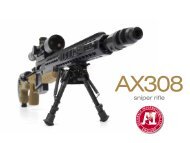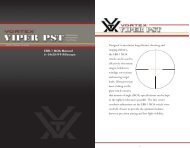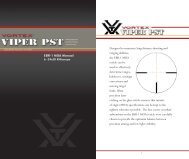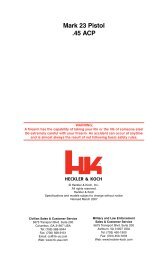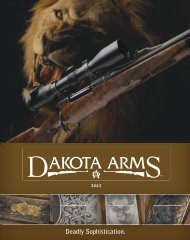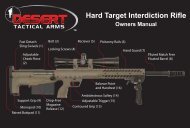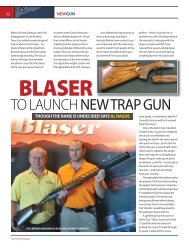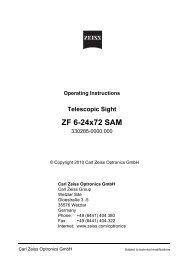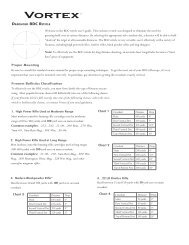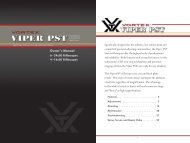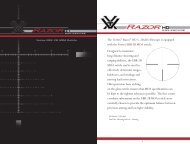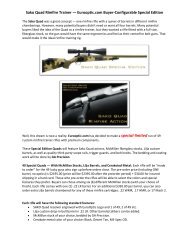vortex viper pst 4-16x50 FFP rifle scope manual - EuroOptic.com
vortex viper pst 4-16x50 FFP rifle scope manual - EuroOptic.com
vortex viper pst 4-16x50 FFP rifle scope manual - EuroOptic.com
- No tags were found...
Create successful ePaper yourself
Turn your PDF publications into a flip-book with our unique Google optimized e-Paper software.
FIRST FOCAL PLANEVortex EBR-1 MOA ReticlePRECISIONSHOOTINGTACTICALEBR-1 MOA Manual4–<strong>16x50</strong> <strong>FFP</strong> Rifle<strong>scope</strong>Designed to maximize long distance shooting andranging abilities,the EBR-1 MOAreticle can be used toeffectively determineranges, holdovers,windage correctionsand moving targetleads. Ultra precisionlaser etching on theglass reticle ensuresthat minute of angle (MOA) specifications can be keptto the tightest tolerances possible. The fine centercrosshair subtensions on the EBR-1 MOA reticle werecarefully chosen to provide the optimum balancebetween precision aiming and low light visibility.1
MOA SubtensionsThe EBR-1 reticle is based on minute-of-angle (MOA)subtensions. Many shootersEstimating MOAare very familiar withAlthough 1 MOA is verythe MOA system used in<strong>com</strong>monly corresponded to 1hunting <strong>rifle</strong><strong>scope</strong>s. MOAinch at 100 yards, this is notmeasurements are basedquite correct 1 MOA at 100on degrees and minutes:yards equals 1.05 inches.360 degrees in a circle,Calling 1 MOA an inch per60 minutes in a degree100 yards may be acceptablefor a total of 21,600at shorter distances, but itminutes. These angularwill cause a fi ve percent errormeasurements are used toin ranging and holdoverestimate range and correctadjustments. This will resultfor bullet trajectory drop in missed shots at longerin <strong>rifle</strong><strong>scope</strong>s. 1 MOA will distances.correspond to 1.05 inches ata 100 yard distance, 2.1 inches at 200 yards, 3.15 inches at300 yards, and so on.as the shooter does not have to remember to set the <strong>scope</strong>to one particular magnification to get valid holdovers—anaction necessary with the more <strong>com</strong>mon second focal planereticles.EBR-1 MOA Reticle SubtensionsHeavy crosshairsubtends 5 MOA5 MOA 2 MOAFine crosshairsubtends .21 MOAGap subtends10 MOAIn the Viper PST first focal plane <strong>rifle</strong><strong>scope</strong>s, the listedMOA subtensions of the EBR-1 reticle are valid at allmagnification levels. This means the shooter can use themagnification level most appropriate for the situation andstill have effective holdover and windage reference marks.This is also extremely valuable in a high-stress situation,2 3
RangingMOA measurements are very effective for rangingusing a simple formula. To use this formula, theshooter needs to know the size of the target ornearby object in inches.ExampleMOA Ranging FormulaTarget Size (Inches) x 95.5Measured MOAs=Range (Yards)Using either the vertical or horizontal MOA scale,place the reticle on a target of known dimensionsand read the number of MOAs spanned. Youwill obtain maximum accuracy in ranging bycalculating exact MOA measurements. MOAsshould be estimated in 1/4s if possible.Accurate measuring will depend on a very steadyhold. The <strong>rifle</strong> should be solidly braced using a rest,bipod or sling when measuring. Once you have anaccurate MOA reading, use the formula to calculatethe distance.Ranging a man (39 inches from groin to top of head)at 6 MOAs yields 621 yards.39 x 95.5= 621 Yards6 MOANote: In the MOA ranging formula, a shooter may substitute 100for 95.5 in the interest of speedier calculations. Be aware that thiswill produce a fi ve percent over-estimation error of the yardagedistance obtained.4 5
Elevation HoldoversOnce the distance has been calculated using theEBR-1 MOA reticle or a laser rangefinder, theEBR-1 can be used for rapid holdover correctionfor bullet drop of the cartridge being used. Toget the most benefit out of the EBR-1 equipped<strong>rifle</strong><strong>scope</strong>, Vortex Optics highly re<strong>com</strong>mendsshooters learn their bullet drop numbers inMOAs rather than inches.ExampleSince the EBR-1 reticle is scaled in 2 MOAincrements, it is an easy job to quickly selectthe correct drop reference line once the shooterknows the bullet drops in MOAs. If the shooterprefers to dial <strong>com</strong>e ups for bullet drop using theelevation knob, knowing bullet drops in MOAsrather than inches will allow for much fasteradjustments as the MOAs can be quickly read onthe elevation knob.17.5 MOA reticle holdover at 625 yards. No wind.6 7
Windage and Moving TargetsThe EBR-1 MOA reticle is highly effective whenused for wind and moving target leads. Using thereticle for effective windage and moving targetleads will require thorough knowledge of yourweapons system’s ballistic performance undervarying conditions and experience in readingwind strengths and target speeds. As in bulletdrops, it is important for the shooter to learna particular weapon’s windage/moving targetcorrections in MOAs rather than inches. Alwayshold the reticle into the wind.Example10 mph windFull value wind at 90 degreesBasic windage correction on center crosshairWhen dialing elevation <strong>com</strong>e ups, the centerhorizontal crosshair will be used for windage ormoving lead corrections.3 MOA reticle windage correction at 400 yards in 10 mphcrosswind using center crosshair. Elevation adjustment alreadydialed into rifl e<strong>scope</strong>.8 9
Basic windage correction using drop line on reticleWhen using the reticle for elevation correction ratherthan dialing, the MOA marks on the center horizontalcrosshair can still be used to help visually referencewindage corrections. Remember to hold the reticleinto the wind.Example20 mph windFull value wind at 90 degreesBasic moving lead correctionWhen estimating moving target leads, the MOA markson the center horizontal crosshair can be used. Estimatingmoving target leads will require knowing yardage distance,wind speed, moving target speed, and total bullet flight time(including <strong>rifle</strong> lock time). Bullet flight times can be roughlycalculated based on fps velocities or a ballistic calculator.Note: Correctly estimating moving leads is very diffi cult and requiresconsiderable practice and knowledge beyond the <strong>scope</strong> of this <strong>manual</strong>.ExampleWalking Direction8 MOA reticle windage correction at 500 yards in 20 mph crosswindusing 12 MOA reticle drop line.9.4 MOA reticle correction for a man walking 3 mph at a distance of800 yards. No wind. Total bullet time of fl ight from trigger pull 1.5seconds during which man travels 6.6 feet. Elevation already dialedinto turret.10 11
Vortex Service and Repair Policy<strong>vortex</strong>optics.<strong>com</strong>Unconditional Lifetime WarrantyVortex Optics wants you to shootand use your Viper PST <strong>rifle</strong><strong>scope</strong>under any conditions with<strong>com</strong>plete confidence—that’s whyour warranty is straightforwardand simple:• Fully transferableUnconditional LifetimeWarranty• No warranty card needed• No receipt neededRest assured, if this <strong>rifle</strong><strong>scope</strong> should ever require repair, allyou need to do is contact Vortex for absolutely free service.Call 800-426-0048 or e-mail service@<strong>vortex</strong>optics.<strong>com</strong>.Vortex Optics2120 West Greenview DriveMiddleton, Wisconsin 53562USAPatent PendingDual Use: Shooting Tactical / HuntingManual #R-416F1-A12



